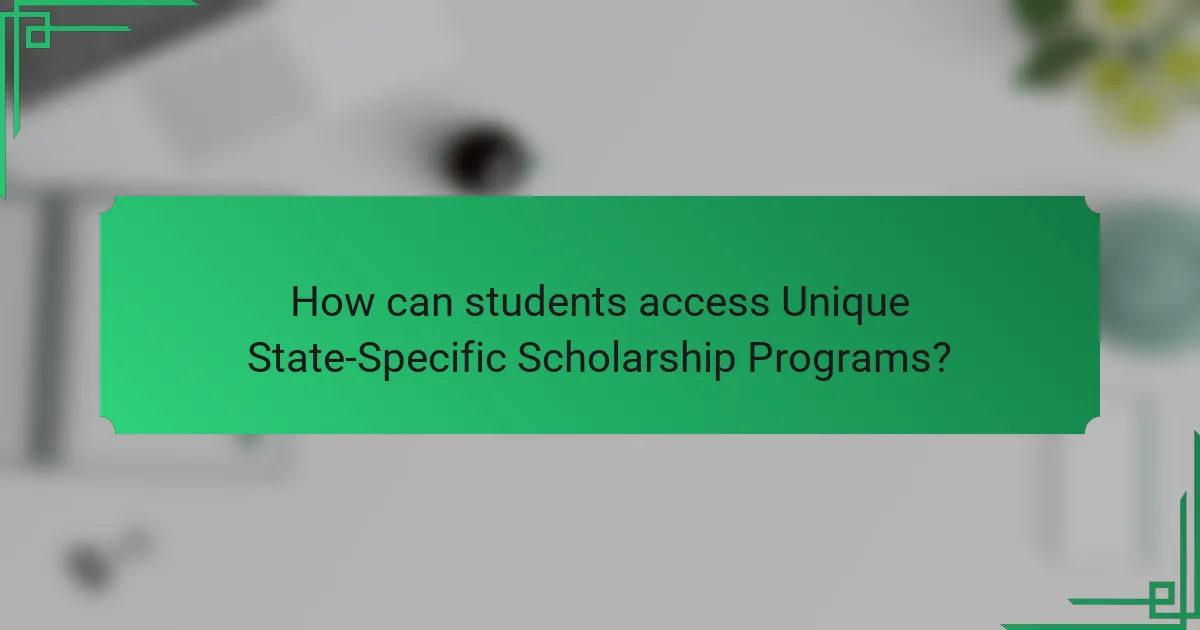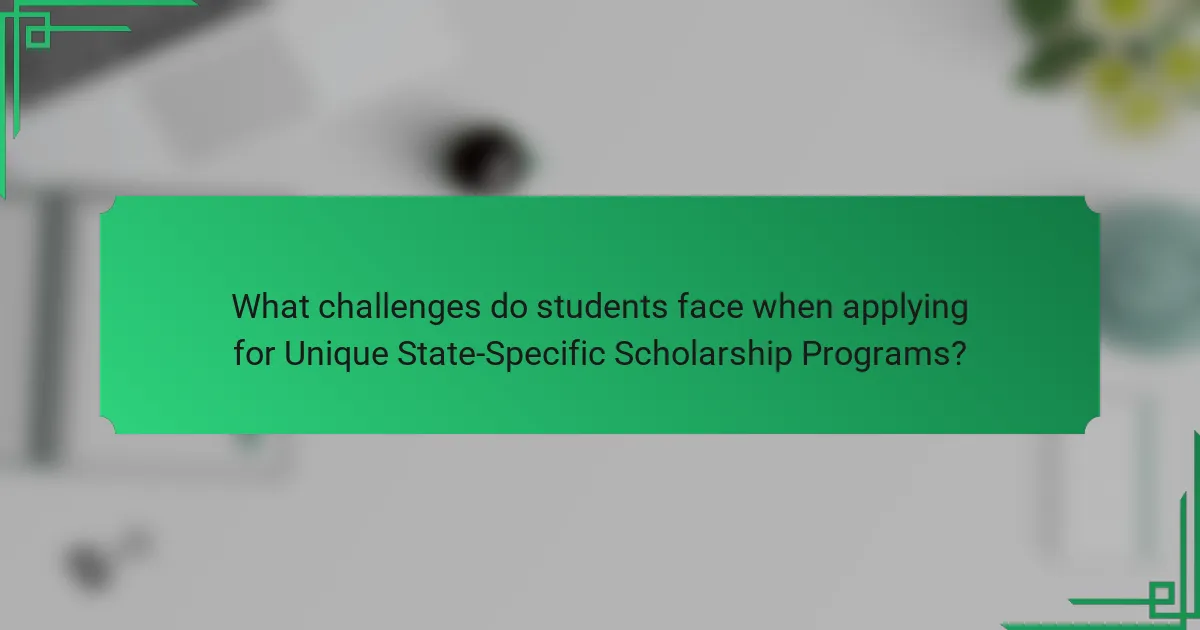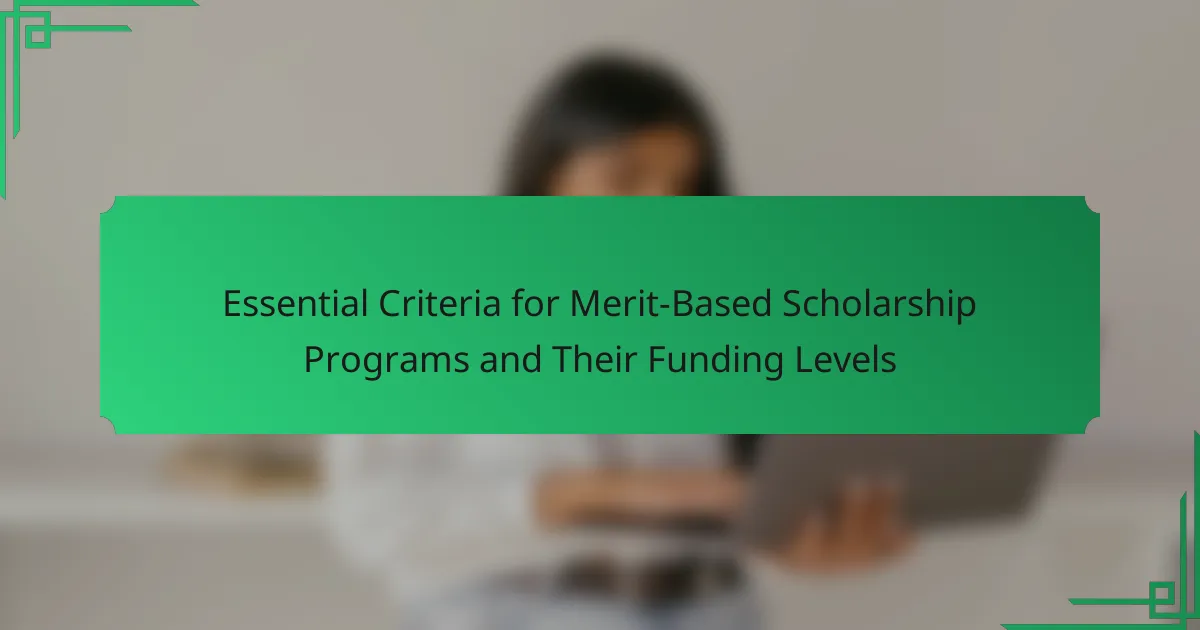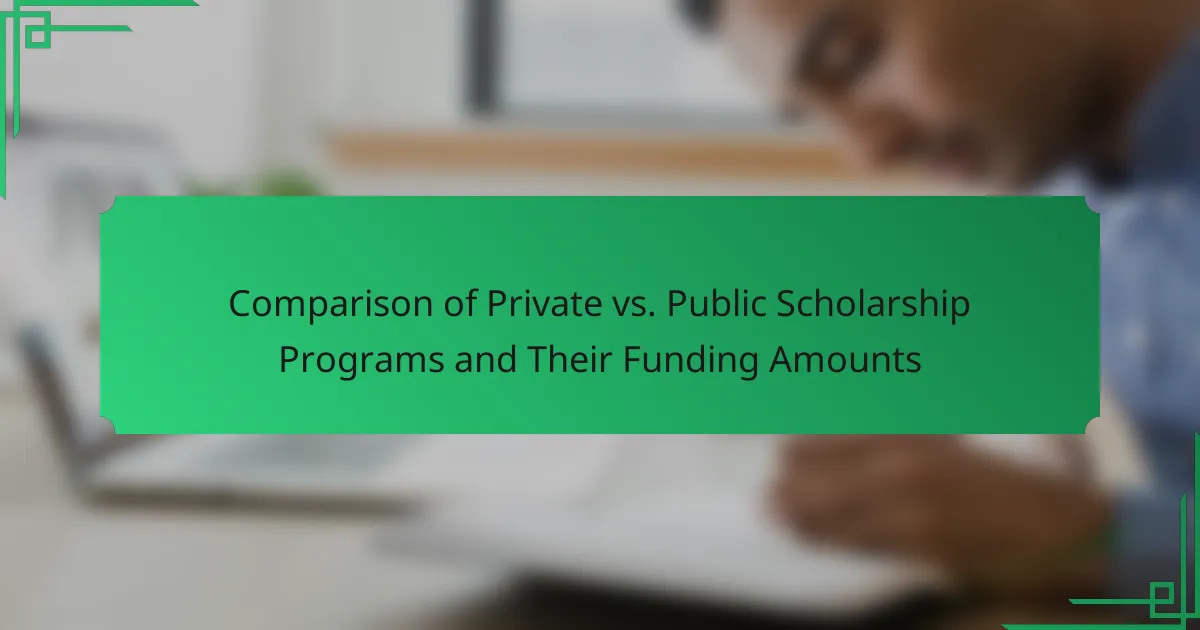
What are Unique State-Specific Scholarship Programs?
Unique State-Specific Scholarship Programs are financial aid opportunities tailored to residents of specific states. These programs often reflect the unique educational needs and priorities of each state. They can be funded by state governments, educational institutions, or private organizations. For example, the California Dream Act allows undocumented students to access financial aid. Similarly, the Texas Advance Commitment offers financial support to in-state students attending public universities. Such programs aim to increase access to higher education for state residents. Each program may have distinct eligibility criteria and application processes. These scholarships can significantly reduce the cost of tuition and related expenses.
How do these scholarship programs differ from traditional scholarships?
Unique state-specific scholarship programs differ from traditional scholarships in their targeted focus. Traditional scholarships often have broad eligibility criteria, catering to a wide range of students nationwide. In contrast, state-specific programs are designed to address local educational needs and demographics. These programs frequently prioritize residents of a particular state or region. They may also consider factors such as state employment needs or local community service. Additionally, state-specific scholarships can be funded by local governments or organizations, unlike many traditional scholarships funded by national entities. This localized funding allows for tailored support aligned with state priorities.
What unique criteria define state-specific scholarship programs?
State-specific scholarship programs are defined by criteria such as residency requirements, academic performance, and field of study. Each state typically mandates that applicants must be residents of that state to qualify. Academic performance criteria often include minimum GPA or standardized test scores. Additionally, some programs focus on specific fields, such as STEM or education. Funding sources can vary, including state budgets, private donations, or endowments. For example, the Florida Bright Futures Scholarship requires a combination of academic achievements and community service. These unique criteria ensure that scholarships align with state goals and support local students.
How do state regulations influence these scholarship programs?
State regulations significantly influence scholarship programs by establishing eligibility criteria and funding mechanisms. These regulations dictate which students can apply based on factors like residency and income. For example, some states require applicants to demonstrate financial need, while others may prioritize specific demographics. Additionally, regulations can determine the amount of funding allocated to each program. This can vary widely from state to state, impacting the overall availability of scholarships. States may also impose restrictions on how scholarship funds can be used, such as tuition only or including living expenses. Consequently, the structure of scholarship programs is heavily shaped by these regulatory frameworks.
What types of funding opportunities are available through these programs?
Unique state-specific scholarship programs offer various funding opportunities. These include merit-based scholarships, need-based grants, and specialized awards for specific fields of study. Some programs provide funding for underrepresented groups or individuals pursuing careers in high-demand industries. Additionally, there are scholarships tied to community service or leadership roles. Many states also offer tuition waivers for residents attending in-state institutions. Each program has specific eligibility criteria and application processes. For example, the Illinois MAP Grant provides financial assistance based on financial need. These opportunities aim to increase access to education for diverse populations.
What are the common sources of funding for state-specific scholarships?
Common sources of funding for state-specific scholarships include state government allocations, private foundations, and educational institutions. State governments often allocate budget funds specifically for scholarship programs. Private foundations may offer grants or endowments to support educational initiatives. Additionally, colleges and universities frequently provide their own scholarships funded through tuition revenue or alumni donations. Federal grants can also supplement state-specific scholarship programs. These funding sources help ensure that scholarships are available to eligible students within the state.
How do public and private entities contribute to scholarship funding?
Public and private entities contribute to scholarship funding through various mechanisms. Public entities, such as government agencies, allocate budgeted funds specifically for educational scholarships. They often create programs aimed at supporting underrepresented students or fields of study. For example, federal and state governments in the U.S. provide Pell Grants and state-specific scholarships, totaling billions annually.
Private entities, including corporations and non-profit organizations, also play a significant role. They offer scholarships to enhance their community engagement and support workforce development. Corporations often establish scholarship funds to attract talent in specific fields relevant to their business. Non-profits may target scholarships to assist low-income or minority students.
According to the National Scholarship Providers Association, private sector contributions to scholarships have increased significantly in recent years. This collaborative funding approach enhances access to education for diverse populations.

How can students access Unique State-Specific Scholarship Programs?
Students can access Unique State-Specific Scholarship Programs through their state education agency or local college financial aid offices. Each state typically maintains a dedicated website listing available scholarships. These resources often include eligibility criteria, application deadlines, and funding amounts. Additionally, students should check with their high school guidance counselors for personalized assistance. Many states also offer online databases that aggregate scholarship opportunities. Engaging in community organizations or local foundations can provide additional information on state-specific scholarships. According to the National Association of Student Financial Aid Administrators, over 30% of students receive funding from state-specific scholarships.
What steps should students take to apply for these scholarships?
Students should begin by researching available state-specific scholarships. This includes identifying eligibility criteria and deadlines. Next, they should gather required documents, such as transcripts and recommendation letters. Completing the scholarship application accurately is crucial. Students must also write a compelling personal statement, highlighting their achievements and goals. After submission, they should follow up to confirm receipt of their application. Finally, students must prepare for potential interviews or additional requirements. These steps ensure a comprehensive application process for state-specific scholarships.
What documentation is typically required for the application process?
Documentation typically required for the application process includes proof of residency, academic transcripts, and financial information. Proof of residency verifies the applicant’s state of residence. Academic transcripts demonstrate the applicant’s educational background and achievements. Financial information, such as tax returns or income statements, assesses the applicant’s financial need. Additional documentation may include letters of recommendation and personal statements, depending on the scholarship program. Each scholarship may have specific requirements, so applicants should review the guidelines carefully.
How do deadlines and eligibility criteria vary by state?
Deadlines and eligibility criteria for scholarship programs vary significantly by state. Each state has its own specific requirements for applicants. For instance, some states require residency, while others may consider academic achievement or financial need. Deadlines can range from early in the academic year to just before the start of the semester. In California, the deadline for the Cal Grant program is typically March 2, while in Texas, the deadline for the Texas Grant is usually in the spring. Eligibility criteria may also include age limits or enrollment status, which differ by state. These variations are essential for students to understand to ensure they meet the necessary requirements for funding.
What resources are available to help students find these scholarships?
Students can utilize various resources to find scholarships. Online scholarship databases like Fastweb and Cappex provide extensive listings. College financial aid offices offer guidance on state-specific scholarships. Local community organizations often sponsor scholarships for residents. High school counselors can assist students in identifying opportunities. State education agencies maintain lists of available scholarships. Nonprofit organizations also provide scholarship information tailored to specific demographics. These resources collectively enhance students’ chances of securing funding for their education.
Which websites and tools are best for researching state-specific scholarships?
The best websites and tools for researching state-specific scholarships include Fastweb, Cappex, and College Board. Fastweb allows users to create a profile and receive personalized scholarship matches. Cappex provides a searchable database of scholarships based on state and academic criteria. College Board offers a scholarship search tool that filters options by state and eligibility requirements. Additionally, state education agency websites often list local scholarships. Community colleges and universities also maintain scholarship databases. These resources help students find funding tailored to their state and circumstances.
How can local community organizations assist in the scholarship search?
Local community organizations can assist in the scholarship search by providing resources and support. They often have information about local scholarships and funding opportunities. These organizations may host workshops to educate students on scholarship applications. They can also offer one-on-one guidance for students seeking scholarships. Many community organizations collaborate with local businesses to create scholarship programs. They may provide networking opportunities with scholarship donors. In addition, some organizations create databases of available scholarships. This access to information can significantly enhance a student’s scholarship search.

What challenges do students face when applying for Unique State-Specific Scholarship Programs?
Students face several challenges when applying for Unique State-Specific Scholarship Programs. One significant challenge is understanding the eligibility criteria, which can vary widely by state. Many students struggle to gather required documentation, such as transcripts or recommendation letters. Additionally, the application process may involve complex forms that can be difficult to navigate.
Time constraints also pose a challenge, as students often balance schoolwork and other commitments. Limited access to information about available scholarships can hinder their ability to apply. Furthermore, competition for these scholarships can be intense, making it harder for students to secure funding.
According to a report by the National Association of Student Financial Aid Administrators, many students overlook state-specific scholarships due to a lack of awareness. This emphasizes the importance of targeted outreach and resources to help students successfully apply.
What common obstacles can hinder the scholarship application process?
Common obstacles that can hinder the scholarship application process include lack of awareness, insufficient documentation, and time constraints. Many students are unaware of available scholarships. This can lead to missed opportunities for funding. Insufficient documentation is another significant obstacle. Applicants often fail to provide necessary transcripts, recommendation letters, or essays. Time constraints can also negatively impact the application process. Many students juggle multiple responsibilities, making it challenging to meet deadlines. Additionally, competition for scholarships can be fierce. High demand can discourage applicants from pursuing opportunities. Understanding these obstacles can help students better prepare for the application process.
How can students overcome financial literacy barriers when applying?
Students can overcome financial literacy barriers when applying by accessing educational resources. Many schools and organizations offer workshops on financial literacy. These workshops cover budgeting, loans, and scholarships. Online platforms also provide free courses on financial management. Students can utilize these resources to gain knowledge. Seeking guidance from financial advisors is another effective method. Advisors can offer personalized advice tailored to individual situations. Additionally, peer support groups can facilitate discussions about financial challenges. Engaging with others can enhance understanding and confidence in financial matters.
What role does competition play in securing state-specific scholarships?
Competition significantly influences the likelihood of securing state-specific scholarships. Many scholarships have limited funding and are awarded based on merit or financial need. High competition can lead to more rigorous selection criteria, making it essential for applicants to present strong academic records and extracurricular involvement. For example, states like California and Texas receive thousands of applications for their scholarship programs annually. This high volume of applicants requires students to distinguish themselves through unique achievements or community service. As a result, competition drives students to enhance their qualifications, ultimately influencing the overall quality of scholarship recipients.
What strategies can students employ to improve their chances of receiving funding?
Students can improve their chances of receiving funding by researching available scholarships thoroughly. They should identify state-specific programs that align with their academic and personal profiles. Tailoring applications to highlight relevant achievements enhances their appeal. Networking with scholarship providers can provide insights and strengthen applications. Meeting deadlines consistently is crucial to avoid missed opportunities. Students should also seek feedback on their application materials from mentors or peers. Maintaining a strong academic record can increase eligibility for competitive funding. Finally, applying for multiple scholarships increases overall chances of securing funding.
How important are personal statements and essays in the application process?
Personal statements and essays are crucial in the application process. They provide insight into the applicant’s personality, motivations, and goals. Admissions committees often use these documents to differentiate between candidates with similar academic qualifications. A well-crafted personal statement can significantly enhance an application. It showcases writing skills, critical thinking, and self-reflection. According to a survey by the National Association for College Admission Counseling, 83% of colleges consider the essay an important factor in admissions decisions. This demonstrates the weight that personal statements carry in the overall assessment of applicants.
What tips can enhance a student’s profile for scholarship consideration?
To enhance a student’s profile for scholarship consideration, students should focus on academic excellence, extracurricular involvement, and strong recommendations. Maintaining a high GPA and achieving strong standardized test scores demonstrate academic commitment. Participation in clubs, sports, or community service showcases leadership and teamwork skills. Building relationships with teachers can lead to personalized and impactful recommendation letters. Crafting a compelling personal statement allows students to express their unique experiences and aspirations. Tailoring applications to specific scholarships highlights alignment with the scholarship’s mission. Meeting deadlines and following application guidelines is crucial for consideration. Research shows that students who engage in these practices significantly increase their chances of receiving scholarships.
What are the best practices for managing scholarship funding once awarded?
Best practices for managing scholarship funding include maintaining accurate records, creating a budget, and adhering to funding guidelines. Accurate records help track expenses and ensure compliance with scholarship terms. A detailed budget allows for effective allocation of funds throughout the academic year. Adhering to funding guidelines ensures that the scholarship funds are used for their intended purpose. Regularly reviewing financial statements can help identify any discrepancies. Engaging with scholarship providers for updates or changes in funding policies is also crucial. These practices enhance accountability and transparency in managing awarded funds.
Unique State-Specific Scholarship Programs are targeted financial aid opportunities designed for residents of specific states, reflecting local educational needs and priorities. These programs, funded by state governments, educational institutions, or private organizations, aim to enhance access to higher education through various funding types, including merit-based scholarships and need-based grants. The article outlines the distinct eligibility criteria, application processes, and the influence of state regulations on these scholarships, as well as the challenges students face when applying. Additionally, it highlights the resources available to assist students in identifying and securing these funding opportunities.



